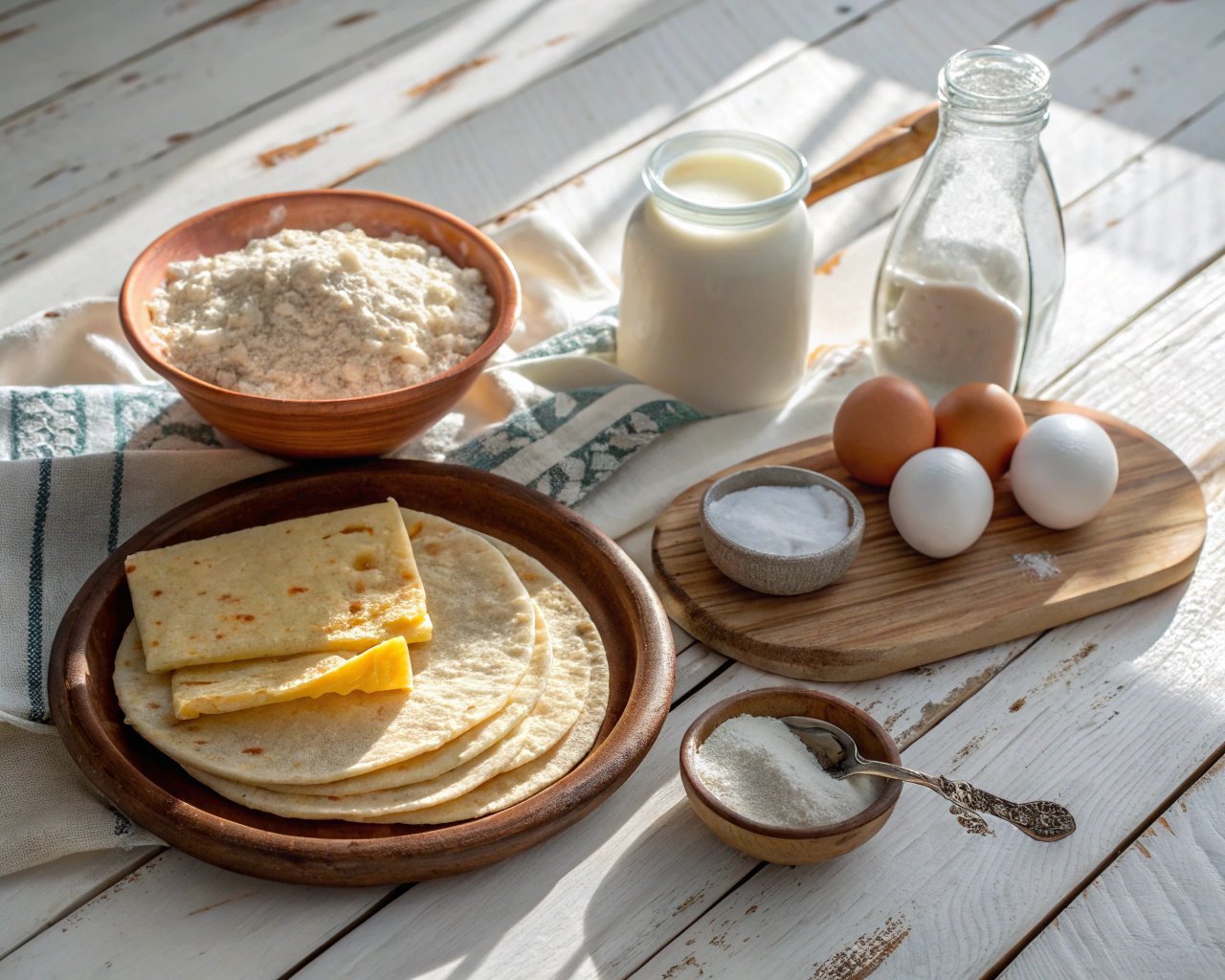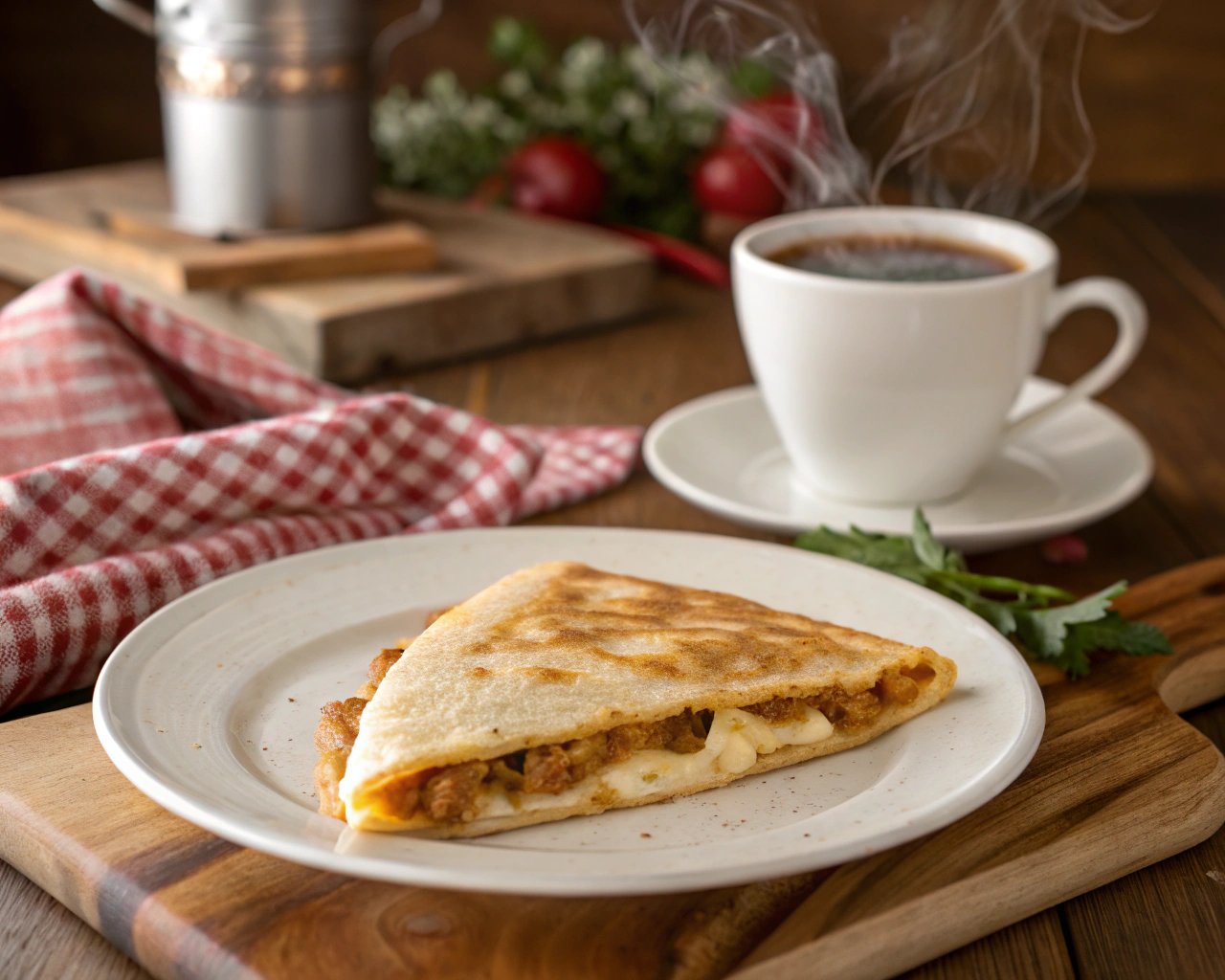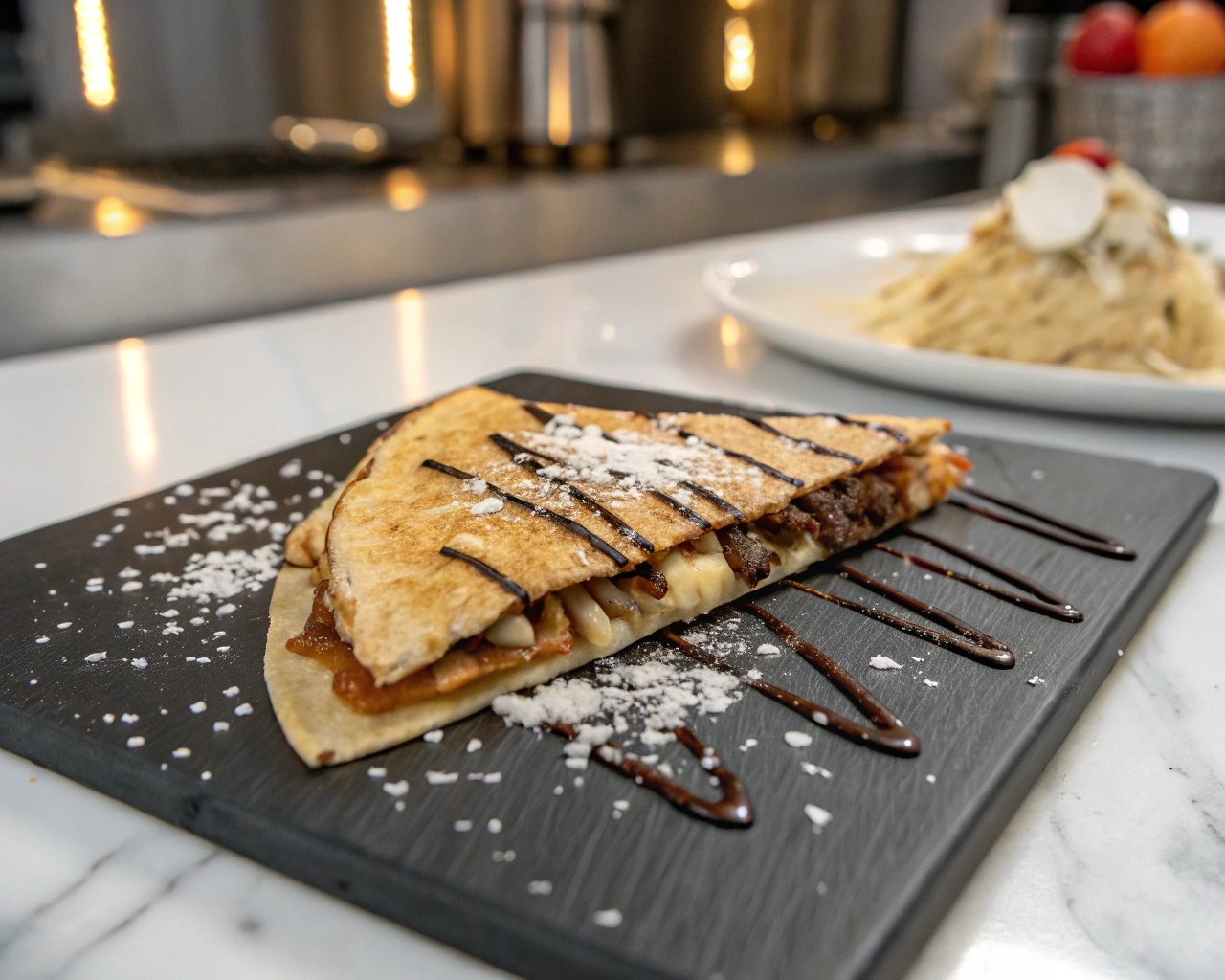The Quesadilla Salvadoreña is a sweet, cheese-based pastry originating from El Salvador. Known for its unique combination of rice flour, cheese, and sugar, this dish stands out as both a snack and a dessert. Unlike its Mexican namesake, which is a savory tortilla filled with cheese, the Salvadoran quesadilla is a baked treat with a soft, cake-like texture. Its flavor profile is rich yet delicate, making it a favorite among locals and food enthusiasts alike.
Table of Contents
History and Cultural Significance in El Salvador
Dating back to the colonial era, the Quesadilla Salvadoreña has roots in both native and Spanish cooking traditions. The use of rice flour, for instance, reflects native influences, while the concept of pastries made with cheese stems from Spanish baking methods. Today, it holds a central place in Salvadoran culture, often enjoyed during family gatherings, religious celebrations, and daily breakfasts. Its significance extends beyond food—serving as a nostalgic link to home for Salvadorans living abroad.
How It Differs from Mexican Quesadillas
It’s important to clear up the confusion between the Quesadilla Salvadoreña and Mexican quesadillas. The latter is a savory dish made with tortillas and melted cheese, often served with meats and vegetables. The Salvadoran version, however, is a sweet baked good with no resemblance to the flat, savory quesadilla. Both dishes showcase their respective countries’ rich cooking traditions, but they cater to entirely different tastes and occasions.
Ingredients Overview
Traditional Ingredients Used
The core ingredients of Quesadilla Salvadoreña include:
- Rice flour: Provides a fine, tender texture.
- Queso fresco: A crumbly cheese that delivers a mild, creamy flavor.
- Cream: Adds richness and freshness.
- Eggs and sugar: For structure and sweetness.
- Sesame seeds: Sprinkled on top for a nutty finish.
These simple yet good ingredients create the unique flavor and texture of quesadilla.

Modern Variations and Substitutions
While the traditional recipe remains beloved, modern adaptations cater to diverse preferences. Some bakers mix in wheat flour for a fluffier texture, while others experiment with cream cheese or goat cheese to intensify the flavor. Without gluten versions often use finely milled rice flour or almond flour as substitutes.
Unique Role of Cheese in the Recipe
Cheese is the heart of the Quesadilla Salvadoreña. It imparts a creamy richness that balances the sweetness of the batter. The choice of cheese—usually queso fresco or cuajada—ensures quality, but mozzarella or ricotta can be used in contemporary versions.
Traditional Baking Process
Step-by-Step Traditional Method
- Prepare the batter: Whisk together rice flour, eggs, sugar, and cream.
- Mix in cheese: Add finely grated queso fresco, ensuring it blends evenly.
- Bake: Pour the batter into a greased pan, sprinkle with sesame seeds, and bake until golden brown.
Importance of Cream and Rice Flour
Cream improves the batter, while rice flour creates the typical crumbly texture. These ingredients cannot be replaced in reaching a real Salvadoran quesadilla.
Variations in Baking Tools and Techniques
Traditionally, quesadillas were baked in clay ovens, which lent a smoky aroma. Today, modern ovens are more commonly used, but some Salvadoran bakers still favor traditional methods for their handmade touch.
The Role of Quesadilla in Salvadoran Cuisine
A Staple in Salvadoran Breakfasts and Snacks
The Quesadilla Salvadoreña is more than a dessert; it’s a staple of Salvadoran breakfasts. Paired with a hot cup of coffee, it’s a comforting start to the day. Its versatility also makes it a popular afternoon snack.

Popularity in Celebrations and Festive Occasions
No Salvadoran celebration is complete without quesadilla. From Christmas feasts to religious ceremonies, this pastry represents kindness and joy. Families often bake it together, passing down recipes through generations.
Key Ingredients: Cheese and Rice Flour
Choosing the Right Cheese for Quality
For a real flavor, queso fresco is the gold standard. Its mildness allows the sweetness of the batter to shine. If unavailable, ricotta or cottage cheese are acceptable alternatives.
Rice Flour vs. Wheat Flour: Texture and Flavor
Rice flour creates a fine, slightly dense crumb, whereas wheat flour results in a lighter texture. Each option has its merits, but rice flour remains true to the dish’s roots.
Cultural Comparisons
Comparing Quesadilla Salvadoreña to Other Cheese-Based Dishes in Latin America
Latin America is rich with cheese-based dishes, from Brazilian pão de queijo to Paraguayan chipa. However, none match the sweet, soft and fluffy texture of the Salvadoran quesadilla.
Influence of native and Spanish Cuisine
The blending of native techniques with Spanish baking traditions shaped the Quesadilla Salvadoreña. This fusion reflects the broader cooking history of El Salvador.
Nutrition and Health Benefits
Caloric Content and Macronutrient Breakdown
On average, a slice of quesadilla contains about 200–300 calories, offering a balance of carbs, fats, and proteins. While indulgent, its use of rice flour makes it lighter than wheat-based pastries.
Without gluten Adaptations and Benefits
Naturally without gluten, Quesadilla Salvadoreña is suitable for those with gluten sensitivities. Its reliance on rice flour makes it a healthier option compared to many baked goods.
The Global Spread of Quesadilla Salvadoreña
Growing Popularity Among Food Enthusiasts Worldwide
Thanks to social media and food blogs, the Quesadilla Salvadoreña is gaining international fame. Its unique flavor and without gluten appeal make it a hit among global foodies.
Availability in International Markets
Salvadoran bread shops abroad often stock quesadilla, and its ingredients are increasingly available in international supermarkets, ensuring its accessibility.
Modern Variations
Sweet vs. Savory Adaptations
While traditionally sweet, some bakers explore savory versions by reducing sugar and adding herbs or spices.
Addition of Local Ingredients from Other Countries
International versions often mix in local flavors, such as coconut in Caribbean-inspired adaptations or matcha in Japanese twists.
Common Pairings
Traditional Drinks to Pair with Quesadilla
Classic pairings include Salvadoran coffee or hot chocolate. These drinks enhance the pastry’s sweetness.
Sides That Enhance Its Flavor
Fresh fruit or a dollop of cream can complement the richness of the quesadilla, offering a refreshing contrast.

How to Make Quesadilla Salvadoreña at Home
Necessary Kitchen Tools
To recreate the Quesadilla Salvadoreña in your kitchen, you’ll need a few basic tools:
- Mixing bowls: For blending dry and wet ingredients separately.
- Hand whisk or mixer: To achieve a smooth batter.
- Baking pan: A rectangular or round pan works best.
- Measuring cups and spoons: For precise measurements.
- Oven or toaster oven: To bake the quesadilla evenly.
While these tools are standard, a clay oven can elevate the flavor if you want to go traditional.
A Beginner-Friendly Recipe
Making Quesadilla Salvadoreña is surprisingly simple. Here’s a recipe perfect for beginners:
Ingredients:
- 2 cups rice flour
- 1 cup grated queso fresco
- 1 cup sugar
- 1 cup sour cream
- 1/2 cup milk
- 4 large eggs
- 2 teaspoons baking powder
- 2 tablespoons sesame seeds (optional)
Instructions:
- Preheat your oven to 350°F (175°C) and grease your baking pan.
- Mix dry ingredients: Combine rice flour and baking powder in a bowl.
- Blend wet ingredients: Whisk eggs, sugar, cream, and milk until smooth.
- Combine and fold: Gradually add the dry mix to the wet mixture, folding in the grated cheese last.
- Pour and garnish: Pour the batter into the prepared pan and sprinkle sesame seeds on top.
- Bake for 35–40 minutes: Check for ready to eat state with a toothpick—it should come out clean.
Step-by-Step Recipe Guide
Preparing the Batter
Getting the batter’s texture right is key. It should be thick enough to hold shape but smooth enough to pour. Overmixing can make the quesadilla dense, so blend ingredients gently.
Baking for Perfect Texture
The baking process is where the magic happens. Ensure your oven is fully preheated, and position the pan in the middle rack for even heat distribution. Keep an eye on the top—once it turns golden brown, it’s ready.
Common Mistakes to Avoid
- Skipping the preheat: This can lead to uneven baking.
- Using the wrong flour: Wheat flour changes the texture entirely.
- Overcooking: This makes the quesadilla dry and crumbly.
Tips for Reaching Real Flavor
Sourcing Traditional Ingredients
The key to uniqueness lies in the ingredients. Visit local Latin markets for queso fresco and cream, or order online from Salvadoran sellers.
Adjusting for Regional Ingredient Availability
If rice flour is unavailable, you can make your own by crushing raw rice in a blender. Substitute cream with crème fraîche for a similar richness.
Regional Variations Within El Salvador
Differences in Recipe Across Regions
While the basic recipe remains consistent, regional variations add unique twists:
- Eastern regions: Prefer a denser texture with more cheese.
- Western regions: Often include a hint of cinnamon or anise.
- Central regions: Focus on simplicity, highlighting rice flour and cheese.
Unique Regional Ingredients
Some areas mix in ingredients like coconut milk or panela sugar for added flavor. These variations reflect the diverse cooking landscape of El Salvador.
Festive Recipes: Quesadilla for Special Occasions
Adding Decorative Touches for Celebrations
For festive occasions, bakers often decorate quesadillas with patterns of sesame seeds or bake them in decorative molds.

Recipes for Large Gatherings
Scaling up the recipe for parties? Use larger pans and adjust the baking time. A batch can be prepared in advance and served warm or at room temperature.
Common Myths About Quesadilla Salvadoreña
Debunking Misconceptions about Ingredients and Methods
- Myth: It’s the same as a Mexican quesadilla.
Truth: They are entirely different dishes. - Myth: Only wheat flour works in baking.
Truth: Rice flour is necessary for uniqueness.
Clarifying Its Relation to Other Pastries
While it shares common features with coffee cakes or pound cakes, the Quesadilla Salvadoreña is unique due to its cheese and rice flour base.
Quesadilla in Salvadoran Communities Abroad
Role in Maintaining Cultural Identity
The Quesadilla Salvadoreña is more than just a pastry—it’s a symbol of Salvadoran heritage. For Salvadorans living abroad, making or sharing quesadilla serves as a powerful connection to their roots. Whether enjoyed at community events or brought to family gatherings, it represents the comforting flavors of home.
In diaspora communities, quesadilla also functions as a cultural ambassador. Offering it to non-Salvadorans opens doors to conversations about Salvadoran traditions, fostering understanding and appreciation of the country’s cooking and cultural richness.
Modern Takes by Chefs and Bakers
Creative Reinterpretations in Fine Dining
In the hands of innovative chefs, the Quesadilla Salvadoreña has been reimagined as part of gourmet menus. For example, chefs might add unexpected ingredients like lavender or honeycomb to elevate its sweetness or mix it into plated desserts with tropical fruit accompaniments.
Fusions with Other World Cuisines
The global influence of Salvadoran cuisine has inspired fusion dishes. Think quesadilla infused with matcha for an East-meets-West dessert or baked with a dulce de leche swirl for a Latin American twist. These adaptations introduce the dish to broader audiences without losing its essence.
Comparing Homemade vs. Store-Bought Quesadilla
Quality and Taste Differences
Homemade quesadillas are often richer and more flavorful, thanks to fresh, high-quality ingredients. Store-bought versions, while convenient, may lack the real texture and flavor due to mass production.
Cost and Convenience Considerations
While homemade quesadillas are economical, store-bought ones save time and effort, especially for busy families. Many bakeries now offer handmade options that strike a balance between realness and convenience.
Handmade Quesadillas: Craftsmanship in Baking
Local Artisans Preserving Tradition
In El Salvador, small bakeries and family-run businesses take pride in preserving the traditional methods of making quesadilla. These artisans often rely on recipes passed down through generations, ensuring each batch reflects the dish’s cultural heritage.
Specialty Ingredients in Gourmet Variants
Handmade quesadillas often use ingredients like organic rice flour or aged cheeses to enhance their flavor. This attention to detail makes them a premium choice for quesadilla enthusiasts.
FAQs About Quesadilla Salvadoreña
What makes Quesadilla Salvadoreña unique?
Its use of rice flour and cheese gives it a unique flavor and texture.
Is it similar to a Mexican quesadilla?
No, they are entirely different dishes.
What cheese should I use?
Queso fresco is the most real choice.
How long does it stay fresh?
Up to three days at room temperature in an airtight container.
What drinks pair well with it?
Coffee or hot chocolate complements it beautifully.
Is it easy to make at home?
Yes, with simple ingredients and basic tools, it’s beginner-friendly.
Can I add other flavors?
Yes, ingredients like cinnamon or coconut can be added.
Where can I buy real quesadilla abroad?
Many Latin American bakeries and specialty stores offer it.
Conclusion and Future of Quesadilla Salvadoreña
The Quesadilla Salvadoreña is a testament to the enduring power of tradition and flavor. As it continues to gain global fame, balancing its rich heritage with modern adaptations will be key to its future. With its growing popularity among chefs, food bloggers, and everyday enthusiasts, the future of this iconic Salvadoran dish looks brighter than ever.
Articles You’ll Love :
- If you’re in the mood for something savory, be sure to check out our Cottage Cheese Flatbread, a deliciously soft and flavorful flatbread that pairs perfectly with any meal.
- If you love sweet Latin desserts, don’t miss our guide to Quesillo: A Creamy Latin Dessert.
- Curious about how quesadilla compares to other traditional treats? Read about The Ultimate Lavash Bread.
- For a rich and indulgent treat, try our Peanut Butter Brownie Recipe.





